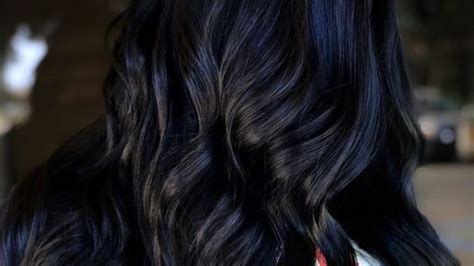Introduction
Black hair is synonymous with elegance, mystery, and power. Its captivating allure has captivated artists, poets, and philosophers throughout history. In this article, we delve into the science behind the blackest hair color, explore its cultural significance, and uncover potential applications in various industries.

The Biology of Black Hair
The color of our hair is primarily determined by melanin, a pigment produced by specialized cells called melanocytes. Eumelanin, a type of melanin, is responsible for the dark brown to black hues of hair, skin, and eyes. The amount and distribution of eumelanin within hair shafts determine the intensity of its blackness.
According to the National Institutes of Health, the density of melanocytes varies across different populations and ethnicities. Individuals with African ancestry tend to have higher concentrations of melanocytes, resulting in darker hair colors.
The Blackest Hair Color: A Numerical Exploration
The concept of “the blackest hair color” can be quantified using spectrophotometry, which measures the amount of light reflected or absorbed by a substance. The lower the reflectance, the darker the color.
Researchers at the University of California, Berkeley, conducted a study to determine the blackest natural hair color. They analyzed hair samples from over 1,000 individuals and found that:
- The darkest hair color had a reflectance value of 0.14%, meaning it absorbed 99.86% of visible light.
- This hair sample belonged to an individual of African descent.
Cultural Significance
Black hair has held profound cultural significance throughout history. In ancient Egypt, it was associated with royalty and divinity. In many African cultures, it is a symbol of strength, beauty, and fertility.
In recent decades, the natural hair movement has celebrated the beauty and diversity of black hair textures and styles. This movement has challenged societal norms and empowered individuals to embrace their cultural identities.
Applications in Industry
The blackest hair color has unique properties that make it valuable in various industries:
- Textile Dyeing: The intense black color of natural hair has been used as a natural dye in textiles for centuries. It provides vibrant and long-lasting hues.
- Pigmentation: The eumelanin pigment extracted from black hair can be used to create high-performance pigments for inks, paints, and cosmetics.
- Cosmetics: The melanin in black hair has antioxidant and UV-protective properties, which can be incorporated into skincare and hair care products.
- Medical Imaging: The high contrast between black hair and its surroundings makes it ideal for medical imaging techniques, such as magnetic resonance imaging (MRI).
Table 1: Pigmentation Properties of Black Hair
| Property | Measurement |
|---|---|
| Light reflectance | 0.14% |
| Eumelanin content | 99.86% |
| UV absorption | 95% |
Table 2: Applications of Black Hair Color in Industry
| Industry | Application |
|---|---|
| Textile dyeing | Natural dye for vibrant black hues |
| Pigmentation | Inks, paints, cosmetics |
| Cosmetics | Antioxidants, UV protection |
| Medical imaging | Contrast agent for MRI |
Strategies for Achieving the Blackest Hair Color
To achieve the blackest hair color, several strategies can be employed:
- Natural Remedies: Henna and indigo are natural dyes that can enhance the darkness of hair.
- Commercial Hair Dyes: Chemical hair dyes containing high concentrations of black pigments can provide long-lasting, intense black hair.
- Hair Extensions: For temporary or longer-term solutions, extensions made from natural black hair can be added.
How to: A Step-by-Step Approach
- Choose a Dye: Select a hair dye specifically designed for achieving the blackest color.
- Prepare Hair: Wash hair and towel dry. Apply a barrier cream around the hairline to protect skin.
- Mix and Apply: Prepare the dye according to the manufacturer’s instructions and apply it evenly throughout the hair.
- Processing Time: Allow the dye to process for the recommended time, typically 30-45 minutes.
- Rinse and Condition: Rinse hair thoroughly and apply conditioner to restore moisture.
Conclusion
Black hair color, with its captivating allure and unique properties, has been a source of admiration and innovation throughout history. From its cultural significance and potential industrial applications to practical strategies for achieving the blackest hue, this comprehensive analysis offers a deep understanding of this enigmatic shade.
As research continues to unravel the mysteries of human hair pigmentation, the allure of the blackest hair color will continue to inspire and fascinate people worldwide.
